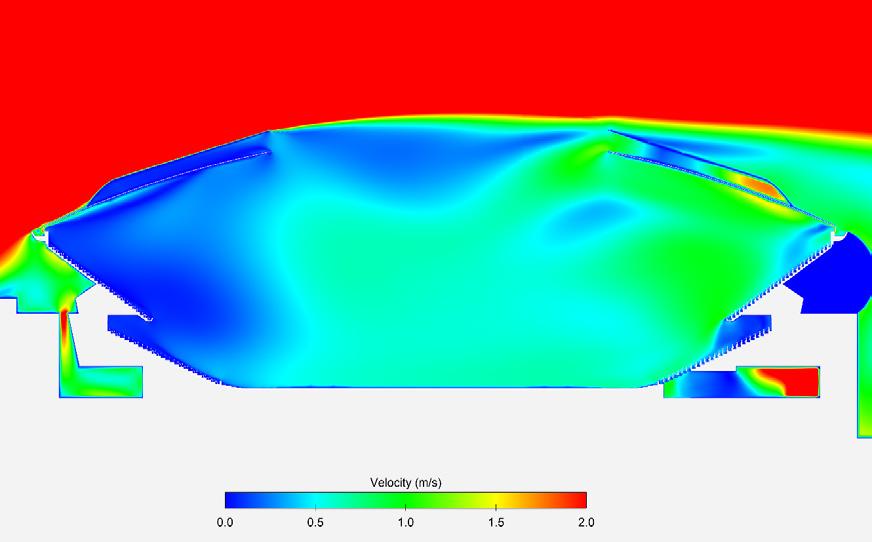AZURE HPC POWERS

WORLD-RECORD SIMULATION
AZURE HIGH PERFORMANCE COMPUTING




AZURE HIGH PERFORMANCE COMPUTING



December 01, 2022 - A team of researchers and technology specialists recently completed a ground-breaking simulation to study aerosol transport, and better understand the potential spread of viruses in packed football stadiums, setting a world record in the process.
Researchers from the University of Eindhoven in the Netherlands and KU Leuven in Belgium were joined by teams from Microsoft and Ansys. Their goal was to leverage the power of Azure High Performance Computing to run one of the largest computational fluid dynamics simulations ever, in addition to investigating aerosol transport in a stadium, under various weather conditions.
The team combined experiments and numerical simulations to investigate atmospheric conditions and aerosol concentrations in a stadium, using pointwise measurements. This would allow the team to better understand how viruses could spread among spectators, which is especially pertinent in light of the FIFA World Cup 2022 which recently took place in Qatar.
Matt Jennings, VP: Global Customer Success at Microsoft, points to the impact of supercomputing capabilities on researchers’ ability to tackle immensely complex challenges in the future. “The combination of technology, innovation and a laser focus on problem-solving is pushing the boundaries of what’s possible and bringing us closer to solving some
of the biggest challenges of our time. Supported by Azure’s supercomputing capabilities, researchers and innovators can now explore solutions that were previously beyond the realm of possibility.”
Football lovers all around the world have been enthralled by the FIFA World Cup 2022. The tournament, which is widely regarded as the centrepiece of global football and draws millions of viewers as well as hundreds of thousands of spectators from all around the globe, was recently held in Qatar, with Argentina emerging victorious.
In the midst of this engrossing experience, the spectre of Sars-COV-2 still loomed large. While significant progress has been made in the rollout of vaccines, in addition to testing so as to help prevent the spread of viruses like Sars-COV-2, there are still concerns around the potential of major sporting tournaments, such as the World Cup, to become super-spreader events.
The highly contagious virus spreads mainly through aerosols suspended in the air. Most football stadiums have semiclosed roofs, with only small facades in
BY RUDEON SNELL: GLOBAL PARTNER LEAD: CUSTOMER EXPERIENCE &SUCCESS AT MICROSOFT
CO-AUTHOR AMIRREZA RASTEGARI, PHD, SENIOR PROGRAM MANAGER, SPECIALIZED COMPUTE ENGINEERING PROJECT DIRECTED BY: GLEN NEWTONMultidisciplinary team achieves world-record simulation powered by Azure High Performance Computing.



the ceiling providing limited ventilation. Aerosol concentrations can reach dangerously high levels in stadiums. Bring together tens of thousands of passionate football fans in a single stadium, cheering and screaming their support for their teams, and the potential for such events to become hubs of transmission, exponentially increases.
To better understand the spread of the virus through football stadiums, the research team developed a simulation based on the Johan Cruijff Arena, the largest in the Netherlands and home to legendary football club Ajax. Bert Blocken, Professor of Civil Engineering at Eindhoven University of Technology & KU Leuven: “Sports have an important role in our society. We started this project because we were concerned for the athletes, spectators, and stadium exploitation. After a large measurement campaign supported by Health-Holland, Sportinnovator and PlasmaMade, it became clear that further insights had to be obtained by computer simulation. The great support by Microsoft and Ansys in running these huge simulations has been instrumental in our success.”
Using Azure High Performance Computing, the team tracked the aerosol distribution of 30 000 spectators under normal atmospheric conditions through a computational fluid dynamics (CFD) simulation. CFD is the analysis of fluid flows through numerical solution methods that enables the analysis of complex problems involving fluid-fluid, fluid-solid and fluid-gas interactions.
The resulting mesh contained nearly 6 billion cells — a world record for this type of CFD simulation on a commercially available solver.
“Pushing simulations to unexplored limits, investigating situations that cannot be properly analyzed otherwise, and preparing for the future when these multibillion-cell models will become routine was the goal of this great collaboration,” said Matt Zack, VP Corporate Development and Global Partnerships at Ansys. “But giving

invaluable insights about aerosol propagation in a full stadium and its environment is an amazing achievement.”



To run such a large and complex simulation, the team needed immense computing power. They chose Azure HBv2 virtual machines using the powerful AMD EPIC 7742 processors, with 4GB of RAM per physical core. Each HBv2 virtual machine provides up to 340GB/second of memory bandwidth and up to 4 teraflops of FP64 computing power.
A total of 300 virtual machines with 96 cores each were used for a total of 28 800 CPU cores running on a total of 55TB of memory. The simulations used Ansys Fluent 2022 R2 with OpenMPI 4.1.1. The virtual machines were connected through a non-blocking fat tree network featuring a 200Gb/second Mellanox HDR InfiniBand.

Following the successful simulation of the Johan Cruijff Arena, the research team also

conducted a simulation considering Qatari weather conditions typical during the FIFA World Cup 2022 to better understand potential aerosol spread during a World Cup match.
Jennings adds: “The success of this project has provided vital insights that can guide innovation across multiple industries in the future. The positive implications of this herculean effort can help support advances in healthcare, especially genomics, advances in manufacturing, especially smart factories and advances in automotive, especially vehicle engineering, aerodynamic simulations, sensor performance, and autonomous driving. Azure High Performance Computing can lay the foundations for next-generation business models, customer experiences and strategic business value to be unlocked.”
To learn more about Microsoft Azure HPC + AI, visit https://www.azure.com/ hpc or to request a demo, contact HPCdemo@microsoft.com


